Development of a Sustainable Maintenance Strategy for Forest Road Wearing Courses in Different Climate Zones
doi: 10.5552/crojfe.2024.2216
volume: 45, issue:
pp: 18
- Author(s):
-
- Motlagh Aiub Rezaee
- Parsakhoo Aidin
- Najafi Akbar
- Mohammadi Jahangir
- Article category:
- Original scientific paper
- Keywords:
- Unpaved Road Condition Index, Unmanned Aerial Vehicle, traffic levels, maintenance budget, Markov chain
Abstract
HTML
This study was done to determine the appropriate maintenance strategies for the deteriorating gravel forest roads in the Mediterranean, sub-humid and semi-arid climates. Unmanned Aerial Vehicle (UAV) was used to monitor Unpaved Road Condition Index (UPCI), immediately after maintenance activities and seasonally in one year. The deterioration time of the wearing course was predicted using Markov chain analysis. Results showed that roads in sub-humid climates presented lower UPCI (7.19) compared to the Mediterranean (7.81) and semi-arid (8.82) climates. When roads were maintained by a high-budget strategy, deterioration time was longer than when other strategies were used. The cost-effectiveness (CE) value of the low-budget strategy was more favorable than different strategies in all traffic levels of the Mediterranean climate and high-traffic roads in a semi-arid environment. Low-budget maintenance activities include one culvert improvement per 6 km, light blading, and 30 mm layer graveling. In a semi-arid climate, a medium-budget maintenance strategy was more efficient in medium and low-traffic roads. Medium, high, and low-budget maintenance strategies were efficient in high, medium, and low-traffic roads in sub-humid climates. High-budget maintenance activities include one culvert improvement per 4 km, heavy blading and local compaction, and 60 mm layer graveling. Overall, it was concluded that monitoring UPCI over time and probability analysis using time series is helpful for a sustainable and long-term management of forest roads.
Development of a Sustainable Maintenance Strategy for Forest Road Wearing Courses in Different Climate Zones
Aiub Rezaee Motlagh, Aidin Parsakhoo, Akbar Najafi, Jahangir Mohammadi
Abstract
This study was done to determine the appropriate maintenance strategies for the deteriorating gravel forest roads in the Mediterranean, sub-humid and semi-arid climates. Unmanned Aerial Vehicle (UAV) was used to monitor Unpaved Road Condition Index (UPCI), immediately after maintenance activities and seasonally in one year. The deterioration time of the wearing course was predicted using Markov chain analysis. Results showed that roads in sub-humid climates presented lower UPCI (7.19) compared to the Mediterranean (7.81) and semi-arid (8.82) climates. When roads were maintained by a high-budget strategy, deterioration time was longer than when other strategies were used. The cost-effectiveness (CE) value of the low-budget strategy was more favorable than different strategies in all traffic levels of the Mediterranean climate and high-traffic roads in a semi-arid environment. Low-budget maintenance activities include one culvert improvement per 6 km, light blading, and 30 mm layer graveling. In a semi-arid climate, a medium-budget maintenance strategy was more efficient in medium and low-traffic roads. Medium, high, and low-budget maintenance strategies were efficient in high, medium, and low-traffic roads in sub-humid climates. High-budget maintenance activities include one culvert improvement per 4 km, heavy blading and local compaction, and 60 mm layer graveling. Overall, it was concluded that monitoring UPCI over time and probability analysis using time series is helpful for a sustainable and long-term management of forest roads.
Keywords: Unpaved Road Condition Index, Unmanned Aerial Vehicle, traffic levels, maintenance budget, Markov chain
1. Introduction
Forest roads are divided into three categories in terms of design and use: primary, secondary, and third-grade roads. In the Hyrcanian forests, main roads account for about 5%, and secondary roads, which are the most critical types of forest roads, account for about 50% of the forest road network (Parsakhoo et al. 2010). Forest roads play an essential role in forest management, wood and non-wood products gathering, recreation, hunting, etc. During the last decade, considerable efforts have been made to prevent forest harvesting, especially in developing countries. These attempts have led to decreased forestry plan incomes and road sector investments (Hrůza et al. 2018, Akay et al. 2020, Fraefel et al. 2021). In Iran, after the implementation of the Law of the Sixth Five-Year Plan of Economic, Social, and Cultural Development (2017–2022), known as »Rest of the Forest«, the repair and maintenance of forest roads stopped due to the suspension of harvesting and closure of projects. Gravel forest roads, as national investments constructed in different climates, have worn out due to this new condition. So, it is necessary to find a sustainable, cost-effective strategy to maintain forest roads over time (Ferenčík et al. 2019, Akay et al. 2021). A method to control road maintenance costs is to obtain and update timely information on the road surface conditions. Sustainable forest road maintenance can be defined as all activities, including regular maintenance functions, blading, reshaping, spot graveling, and other tasks that provide and maintain road surfaces at an adequate level of service for a long term (Chamorro Giné and Tighe 2009,Yurtseven et al. 2019, Akgul et al. 2019).
In the Hyrcanian forests, the mean average funding level for the support travel system and road maintenance per year was 433 $, ranging from 400$ to 470$, with an overall decreasing trend. Most forest roads in this region are gravel roads. Gravel roads consist of a layer of mountainous sand or river materials, constructed based on specified standards and provide a passable all-weather surface. A standard gravel forest road consists of 40–80% gravel, 20–60% sand, and 8–15% fine particles (Gotosa et al. 2015, Parsakhoo et al. 2021). Corrugations, potholes, erosion, rutting, dustiness or presence of fine material, exposed large aggregates, gravel loss, crown and roughness defects, poor cross-fall and profile are the common problems that can be observed on surfaces of gravel forest roads (Setyawan et al. 2015, Yoshida et al. 2016, Qiao et al. 2020). Recent studies have evaluated different management tools to find a cost-effective and efficient strategy for road maintenance. In Iran, the Genetic Algorithm was evaluated by Heidari et al. (2018) to identify the warning level of the wearing course and provide a plan for the maintenance of the forest road network over five years. Goudarziand Najafi (2018) showed that the Analytical Hierarchical Process (AHP) could prioritize forest road maintenance from different spatial and temporal points of view using the generated model according to expert knowledge and effectiveness of these factors.
Models were developed from the probabilistic analysis of field assessments, calibrated with Markov chains and Monte Carlo for simulating wearing course deterioration over time. One of the advantages of this technique is that it can be used by forest engineers with scarce technical resources and historical data (Osorio-Lird et al. 2018). Markov chain analysis of the Unpaved Road Condition Index (UPCI) is one of the most effective tools for risk analysis. This tool can predict wearing course conditions and the suitable timetable for maintenance operation (Pazhouhan et al. 2020). Unpaved road condition performance depends on the sub-based materials, climate condition, wearing course thickness, road age, traffic volume, and the strength of surfacing materials. Severe climate, traffic, or poor structural strength increase the failure probability of wearing courses (Aruga et al. 2022).
Timely and proper maintenance of forest roads is essential for sustainable serviceability of roads, and an effective method to detect road surface problems is the use of Unmanned Aerial Vehicles (UAV) (Tan and Li 2019). UAVs are considered valuable tools for acquiring reliable information about the surface of the forest road (Dadrasjavan et al. 2019). Ruzgienė et al. (2015) showed that the correctness of the digital surface model for roads generally depends on camera resolution, flight height, and accuracy of ground control points. Determining road maintenance type and cycle is one of the forest engineers' issues and challenges (Grajewski 2016). Moreover, estimating probable time and project budget is still a challenge for managers due to traditional project control.
In this study, we tried to present a method for considering the probability of a forest road deterioration in terms of time and cost. Road maintenance tools commonly require detailed road condition data, comprehensive field evaluations, complex processes for model calibration, and long-term perspective. It can be stated that there is no sustainable maintenance program currently available in Hyrcanian forests that can overcome the four problems described above. The objectives of this research were to:
Investigate the effect of traffic levels, maintenance budget levels, and climate conditions on the deterioration of forest roads
Determine the best time of maintenance activities based on probability analysis and UPCI methodology
Determine the proper maintenance and repairing activities to slow road deterioration.
2. Material and Methods
2.1 Description of Study Area
The study was conducted in three different climate zones within the Hyrcanian forests in the north of Iran (Fig. 1). These forests stretch 850 km along the southern coast of the Caspian Sea in the temperate broadleaf and mixed forest biome. In these regions, the road network is used by forestry machinery and public transport on holidays.This traffic can increase the damage to unpaved roads. General characteristics of study areas are illustrated in Table 1.
Table 1 General characteristics of study areas
|
Study area |
Mediterranean zone Shastkalateh |
Sub-humid zone Rezaeian |
Semi-Arid zone Arabdagh |
|
Coordinate |
54°21´26´´ to 54°24´57´´N 36°43´27´´ to 36°48´06´´E |
55°01´00´´ to 55°06´30´´N 36°52´30´´ to 36°48´01´´E |
55°37´04´´ to 55°47´07´´N 37°32´01´´ to 37°36´05´´E |
|
Forest extent, ha |
1713.3 |
12,465 |
2240 |
|
Elevation range, m |
230–700 |
790–1270 |
200–955 |
|
Lithology |
Lime and sandstone (conglomerate) |
Lime – Marl and dolomite lime |
Lime – loess deposits |
|
Soil type |
Silt clay loam – Silt clay |
Silt clay loam – Silt clay |
Silt loam – Silt clay loam |
|
Mean annual rainfall, mm |
526 |
583.1 |
536.7 |
|
Mean annual temperature, °C |
15.4 |
12.9 |
16.9 |
|
Aridity index |
20.71 |
25.46 |
19.95 |
|
Dominant forest species |
Carpinus betulus L. Parrotia persica C.A.Mey |
Carpinus betulus L. Tilia begonifolia |
Carpinus betulus L. Zelkova carpinifolia |
|
Road length, km |
30.3 |
108.8 |
25 |
|
Road density, m/ha |
18.1 |
8.4 |
11.1 |
|
Longitudinal slope, % |
5 |
6 |
4 |
|
Transverse slope, % |
3 |
2 |
4 |
|
Geographical direction |
Northern to eastern |
Northern to eastern |
Northern to eastern |
|
Hillside slope, % |
30 |
40 |
20 |
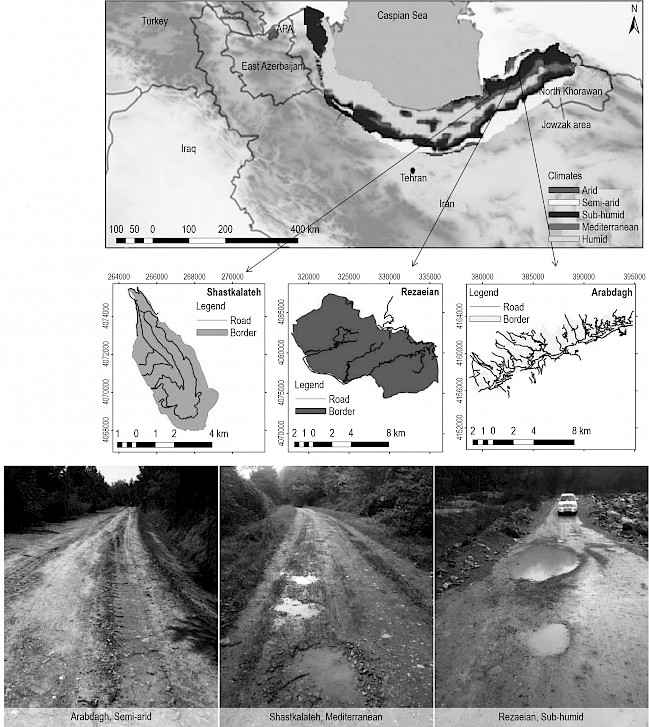
Fig. 1 Position of study areas according to classification of Hyrcanian forest climate using de Martonne aridity index
2.2 Case studies Inventory and Field Data
In this study, UAV was used to monitor unpaved road conditions based on UPCI (Chamorro Giné and Tighe 2019). These involve a RGB camera of 12 Megapixels to quantify the extent and severity of road problems observed on road sample units. Three traffic levels and three maintenance budget levels were found in each climate zone - the Mediterranean, sub-humid, and semi-arid climate. In each climate, 18 sample units, each with a length of 500 meters, were randomly selected on the road network. A total of 54 sample units and 27 km of roads were monitored in this study. Evaluations were made immediately after each season for one year to capture the effects of climate on the road surface. A total of 27 km of roads were surveyed in three environments. UPCI was estimated using Eq. 1 (Chamorro Giné and Tighe 2019).
UPCI = 10 - 1.16CR - 2.25PT - 1.47ER - 0.33RT - 1.56OA - 1.58CW (1)
Where:
CR corrugations evaluated as the mean vertical distance between the highest and lowest point of the three consecutive deformations in centimeters
PT potholes measured as the product of the mean diameter in meters, depth in meters, and number of potholes in a sample unit
ER erosion is a nominal variable considered one if either erosion depth is greater than 5 cm or width is greater than 10 cm
RT mean vertical distance between the highest and lowest point of a rut obtained from three measures per wheel path in cm
OA exposed large aggregate is a nominal variable, considered one if large aggregate with mean diameters greater or equal to 5 cm
CW crown condition is a nominal variable considered as 0 if the crow has good condition, 0.5 in fair condition, and one in poor condition (Chamorro Giné and Tighe 2019).
UPCI values for gravel roads in different climates are shown in Table 2.
Table 2 UPCI values for gravel roads in different climates (Chamorro Giné and Tighe 2019)
|
Condition |
Semi-Arid |
Mediterranean |
Sub-Humid |
|
Very good |
8.2 to 10 |
8.2 to 10 |
8.2 to 10 |
|
Good |
5.2 to 8.1 |
5.7 to 8.1 |
7.2 to 8.1 |
|
Regular |
4.2 to 5.1 |
4.7 to 5.6 |
5.2 to 7.1 |
|
Poor |
2.2 to 4.1 |
2.7 to 4.6 |
3.7 to 5.1 |
|
Very poor |
1 to 2.1 |
1 to 2.6 |
1 to 3.6 |
2.3 Road Defect Analysis
The road wearing course defects were detected with the use of arotary wing UAV. This Quadcopter can be controlled either by autonomous mode or manual mode. The total duration to fly the UAV is 30 minutes at an altitude of 60 m. Collected images were processed using Agisoft Metashape software (Fig. 2). After the image processing, the wearing course distress (in pixels) was used to do the severity analysis (Saha and Ksaibati 2017). Support vector machine (SVM) in eCognition software was used to classify different road defects (Fig.3). The classification process was done with decision trees. The depth and surface of defects were measured in ArcGIS 10.1 (Bicici and Zeybek 2020).
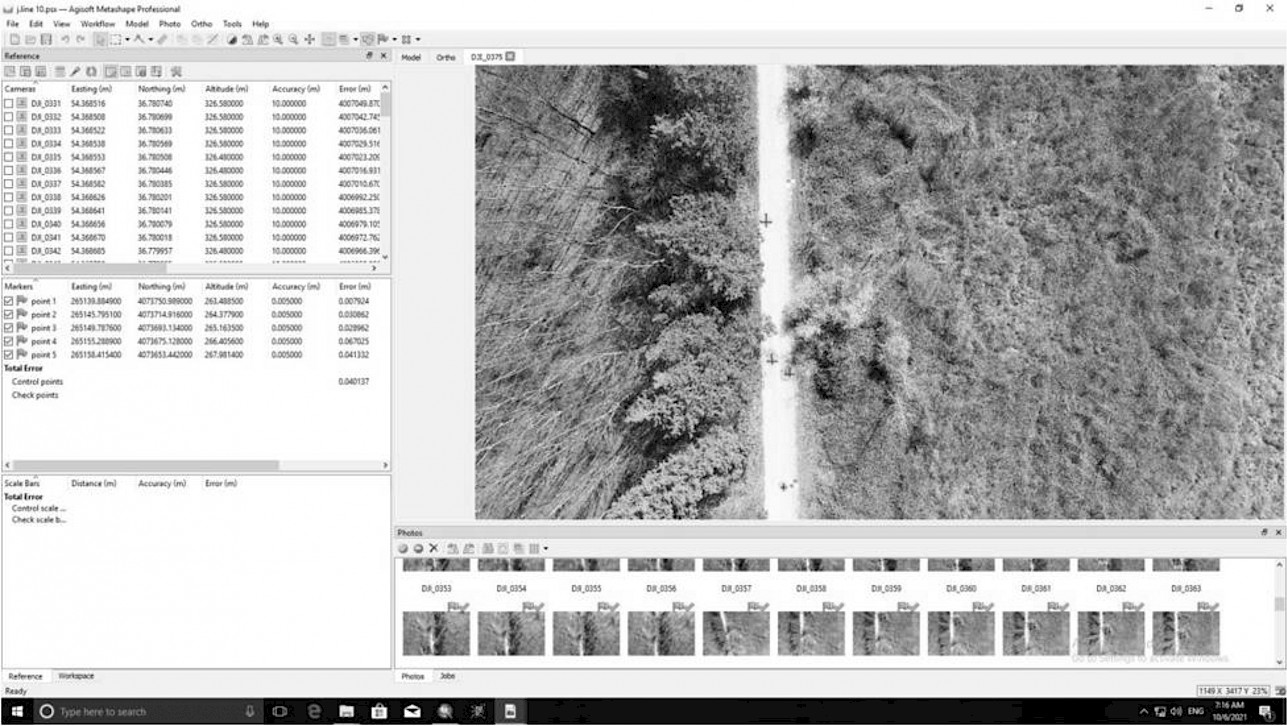
Fig. 2 UAV image processing in Agisoft
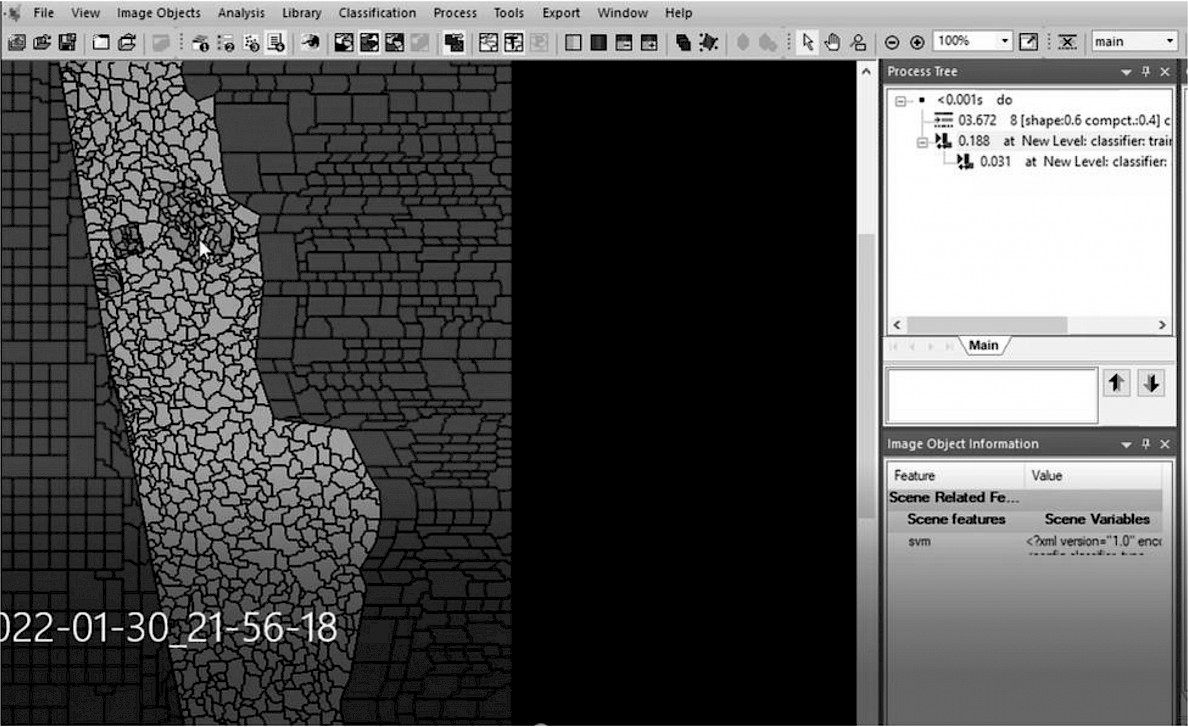
Fig. 3 Auto classification for detection of road damages in SVM
2.4 Classification of Traffic and Budget Levels
Most of the road wearing course deterioration caused by traffic is related to the traffic volume. In this study, low and moderate-volume traffic gravel roads commonly present less than 10 and 10–20 vehicles per day. In addition, traffic volumes higher than 20 vehicles per day were classified as high traffic (Table 3). Three budget levels were considered in the definition of maintenance strategies: Low, Medium, and High. Budget levels and related maintenance activities are presented in Table 4.
Table 3 Traffic levels
|
Traffic volume |
Low traffic |
Moderate traffic |
High traffic |
|
Average Daily Traffic (ADT) |
<10 |
10–20 |
>20 |
Table 4 Road maintenance strategies in different budget levels
|
Maintenance strategy |
Low budget |
Medium budget |
High budget |
|
Drainage and culvert improvement |
1 per 6 km |
1 per 4 km |
1 per 2 km |
|
Grading |
Light blading or grading |
Heavy blading or grading with localized compaction |
Heavy blading with reshaping, forming and compaction |
|
Local gravelling, pothole patching |
6 m3 per km |
12 m3 per km |
18 m3 per km |
|
Gravelling |
30 mm layer |
60 mm layer |
100 mm layer |
2.5 Markov Chain Analysis
To analyze the reliability of large systems using the Markov chain, the method of solving the probability matrix of random state change is used. The development of the Markov chain model is the generation of probabilities that can define the potential of the states of a road in different situations. A string of random variables X1, X2, X3,…, Xn is called a Markov chain if it holds for all values of n and all states i and j (Eq. 2).
 (2)
(2)
Where:
n is also called road condition.
The probability of changing the state of the system from state i to state j, or in other words, the probability of the point moving on the line is as given by Eq. 3 and Eq. 4 (Hillier and Lieberman 2005, Elhadidy et al. 2015).
 (3)
(3)
 (4)
(4)
In a homogeneous Markov chain, Pij represents the probability of system state change from i to j. The general form of the transition probability matrix is as follows: where its constituent element in row i and column j is the value of Pij or the probability of changing the state of the system from form i to form j. Assuming that the number of forms of the system is M, the transition matrix will be as given by Eq. 5 (Hillier and Lieberman 2005, Elhadidy et al. 2015).
 (5)
(5)
The initial state of the road is expressed by the initial vector matrix IP0 based on the index value of the road condition in the initial year. The IP0 matrix is formulated based on Eq. 6 (Hillier and Lieberman 2005, Elhadidy et al. 2015).
 (6)
(6)
The vectors of this matrix are the percentage of road sections that are in excellent, good, bad, poor, and discrete conditions. Knowing IP0 and the vector of future road conditions (FPt) and the vector of possible states (PS) after a transition period t (Eq. 7), Pij is obtained from Eq. 8 (Hillier and Lieberman 2005, Elhadidy et al. 2015).
 (7)
(7)
 (8)
(8)
Where:
nij is the number of transitions from state i to state j in a certain period and ni is the total number of road elements in state i before its transition.
2.6 Cost-Effectiveness Analysis
In this study, Effectiveness (E) of different maintenance strategies was estimated using Eq. 9 (Chamorro Giné and Tighe 2009).
 (9)
(9)
Where:
UPCIT is UPCI after yearly maintenance until UPCI minimum is reached
PCIM is minimum acceptable UPCI
UPCIN is yearly UPCI from the needs year to the maintenance year
AADT is annual average daily traffic, and LS is road length.
The Unit Effectiveness (UE) for a semi-annual cycle of a 10-year analysis period was calculated using Eq. 10 (Chamorro Giné and Tighe 2009).
 (10)
(10)
Where:
UPCIB is UPCI before applying the maintenance strategies
UPCIA UPCI immediately after using the maintenance strategy.
The Cost Effectiveness (CE) of each technique was calculated following Eq. 11 (Chamorro Giné and Tighe2009).
 (11)
(11)
Where:
PWC is the present worth of maintenance costs, the maintenance cost range for low, medium, and high budget strategies in Hyrcanian forests was 110–125$/km, 185–230 $/km, and 281–333 $/km, respectively.
2.7 Statistical Analysis
Experiment factorials were defined in this study. This factorial, including UPCI as a dependent variable, and climate, traffic,and maintenance budget levels as independent variables, was designed in SPSS Statistics version 23 software (Fig.4). The normality of the data was tested using the Kolmogorov-Smirnov. MATLAB software was used to predict the deterioration time of the wearing course of different forest roads using the Markov chain time series.

Fig. 4 Factorials to assess the effect of traffic, budget and climate on UPCI
3. Results
3.1 Analysis of Variance for Effects of Independent Variables on UPCI
Results indicated that UPCI significantly differed among semi-arid, sub-humid, and Mediterranean climates (p<0.01). Road maintenance strategies with varying budget levels had a significant effect on UPCI values, as a lower UPCI was observed in roads with low-budget maintenance (p<0.01). Results indicated that traffic levels or severity on forest roads could significantly change the UPCI (p<0.01). There were no significant interaction effects of the mentioned independent parameters on UPCI (p>0.05), except for climate and traffic (p<0.05, Table 5).
Table 5 Analysis of variance for effects of independent variables on UPCI
|
Source |
df |
Sum squares |
Mean squares |
F |
|
Corrected model |
26 |
184.72 |
7.10 |
6.10** |
|
Intercept |
1 |
12,935.92 |
12,935.92 |
1.111E4** |
|
Climate |
2 |
38.45 |
19.22 |
16.51** |
|
Maintenance strategy |
2 |
63.45 |
31.73 |
27.25** |
|
Traffic |
2 |
44.63 |
22.32 |
19.17** |
|
Climate× Maintenance strategy |
4 |
5.51 |
1.38 |
1.18ns |
|
Climate×Traffic |
4 |
19.37 |
4.84 |
4.16* |
|
Maintenance strategy×Traffic |
4 |
1.68 |
0.42 |
0.36ns |
|
Climate×Maintenance strategy×Traffic |
8 |
11.08 |
1.39 |
1.19ns |
|
Error |
189 |
220.05 |
1.16 |
– |
|
Total |
216 |
13,355.03 |
– |
– |
|
Corrected total |
215 |
404.77 |
– |
– |
|
*, ** – significant at probability level of 95 and 99%, respectively ns – not significant |
||||
3.2 Effect of Maintenance Strategies with Different Budget Levels on UPCI
Fig. 5 presents a comparison of the mean conditions of roads in different road maintenance strategies in Mediterranean, semi-arid, and sub-humid climates. In all studied climate zones, UPCI values for roads maintained with a low budget standard were significantly lower than with two other budget classes (p<0.05). For roads that were supported with a high budget in the Mediterranean climate, the road UPCI was initially 9.2, but after a year, it was reduced to 7.7 (annual deterioration of 15.5%). The annual deterioration rates of forest roads in semi-arid and sub-humid climates were 15.6% and 23.9%, respectively. For roads that were maintained with a medium budget in the Mediterranean climate, the road UPCI was initially 8.8, but after a year, it was reduced to 6.9 (annual deterioration of 21.4%). The deterioration rate of forest roads in semi-arid and sub-humid climates was 14.1% and 26.4%, respectively. For roads that were maintained with a low budget in Mediterranean climate, the road UPCI was initially 8.3, but after a year, it was reduced to 6.5 (annual deterioration of 21.4%). The deterioration rate of roads in semi-arid and sub-humid climates was 29.7% and 24.8%, respectively.

Fig. 5 Comparisons of UPCI among different maintenance budget levels in Mediterranean, semi-arid, and sub-humid climates (different letters show significant differences at a probability level of 5%)
3.3 Effect of Traffic Levels and Climate on UPCI
Fig. 6 presents a comparison of the mean conditions of roads in different traffic levels in Mediterranean, semi-arid, and sub-humid climates. In all studied climate zones, UPCI values for roads with low traffic were significantly higher than with two other traffic levels (p<0.05). For forest roads with a high-traffic volume in the Mediterranean climate, the road UPCI was initially 8.3, but after a year, it was reduced to 5.9 (annual deterioration of 29.3%). The annual deterioration rates of forest roads in semi-arid and sub-humid climates were 19.8% and 31.0%, respectively. For roads with a medium-traffic volume in Mediterranean climate, the road UPCI was initially 8.7, but after a year, it was reduced to 7.1 (annual deterioration of 16.0%).The deterioration rate of forest roads in semi-arid and sub-humid climates was 18.6% and 20.2%, respectively. For roads with a low-traffic volume in Mediterranean climate, the road UPCI was initially 9.2, but after a year, it was reduced to 8.2 (annual deterioration of 10.9%). The deterioration rate of roads in semi-arid and sub-humid climates was 20.2% and 21.0%, respectively (Fig. 6). From the analysis of mean data, it is observed that there are significant differences among climates. Sub-humid climate presented significantly lower UPCI (7.19) than the two other environments. UPCI values for Mediterranean and semi-arid climates were 7.81 and 8.82, respectively (Fig. 7).

Fig. 6 Comparisons of UPCI among different traffic levels in Mediterranean, semi-arid, and sub-humid climates (different letters show significant differences at a probability level of 5%)

Fig. 7 Comparisons of UPCI among different climates (different letters show significant differences at a probability level of 5%)
3.4 Analysis of Road Condition Performance Curves
The road surface performance curves, obtained from the time series simulation of roads with different maintenance strategies and traffic levels are presented in Fig. 8. Each graph includes three curves, representing the performance observed under semi-arid, Mediterranean, and sub-humid climates. In high-traffic roads in semi-arid climate, the curves show the slow down trend of UPCI for all maintenance strategies (Fig. 8a), whereas the curves show rapid decline of UPCI in medium and low-traffic roads maintained by low-budget. The UPCI performance of medium and low-budget strategies was the same in medium (Fig. 8b) and low-traffic roads (Fig. 8c). In Mediterranean climate, a similar trend was observed for different maintenance strategies in each traffic level - high (Fig. 8d), medium (Fig. 8e), and low (Fig. 8f). As expected for sub-humid climate, the UPCI value drops significantly during the first year of service especially in high-traffic roads due to the appearance of distress caused by traffic and climate (Fig. 8g). High-budget maintenance strategy in medium traffic roads can increase the road service life (Fig. 8h), while the UPCI performance of different maintenance strategies in low-traffic roads is the same (Fig. 8i). In the last three to five years of service, a wearing course of road faces severe problems and is in poor, and very poor condition, resulting in UPCI values less than 4.

Fig. 8a UPCI performance curves over time for roads with different maintenance strategy and high traffic levels in semi-arid zone

Fig. 8b UPCI performance curves over time for roads with different maintenance strategy and medium traffic levels in semi-arid zone

Fig. 8c UPCI performance curves over time for roads with different maintenance strategy and low traffic levels in semi-arid zone
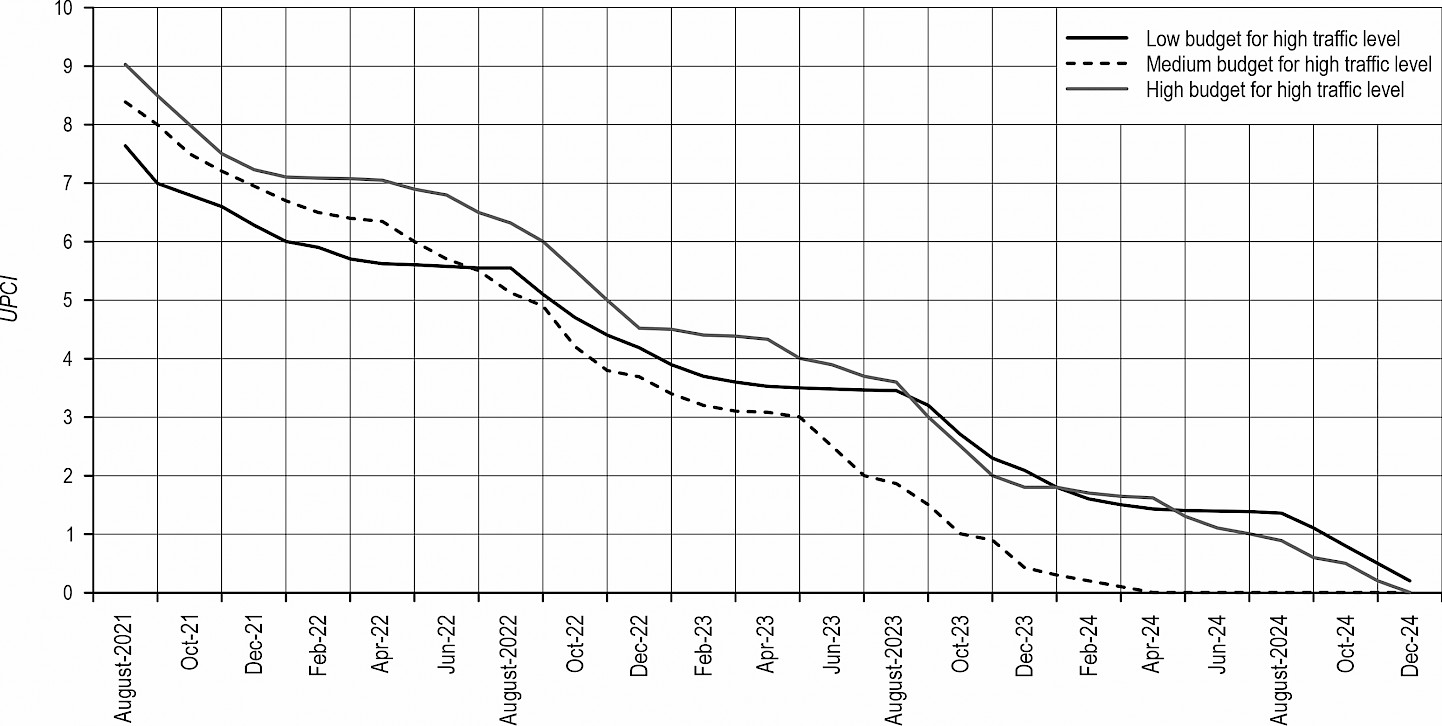
Fig. 8d UPCI performance curves over time for roads with different maintenance strategy and high traffic levels in Mediterranean zone

Fig. 8e UPCI performance curves over time for roads with different maintenance strategy and medium traffic levels in Mediterranean zone
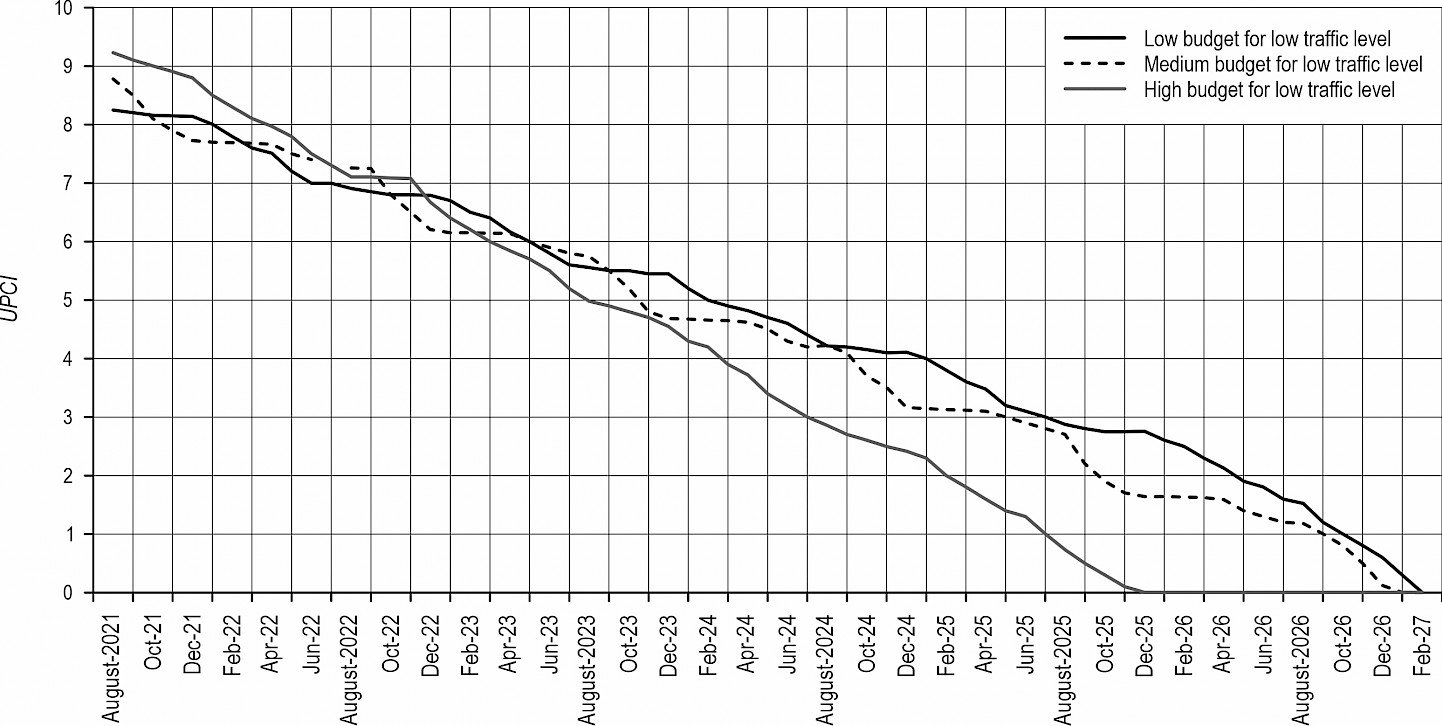
Fig. 8f UPCI performance curves over time for roads with different maintenance strategy and low traffic levels in Mediterranean zone
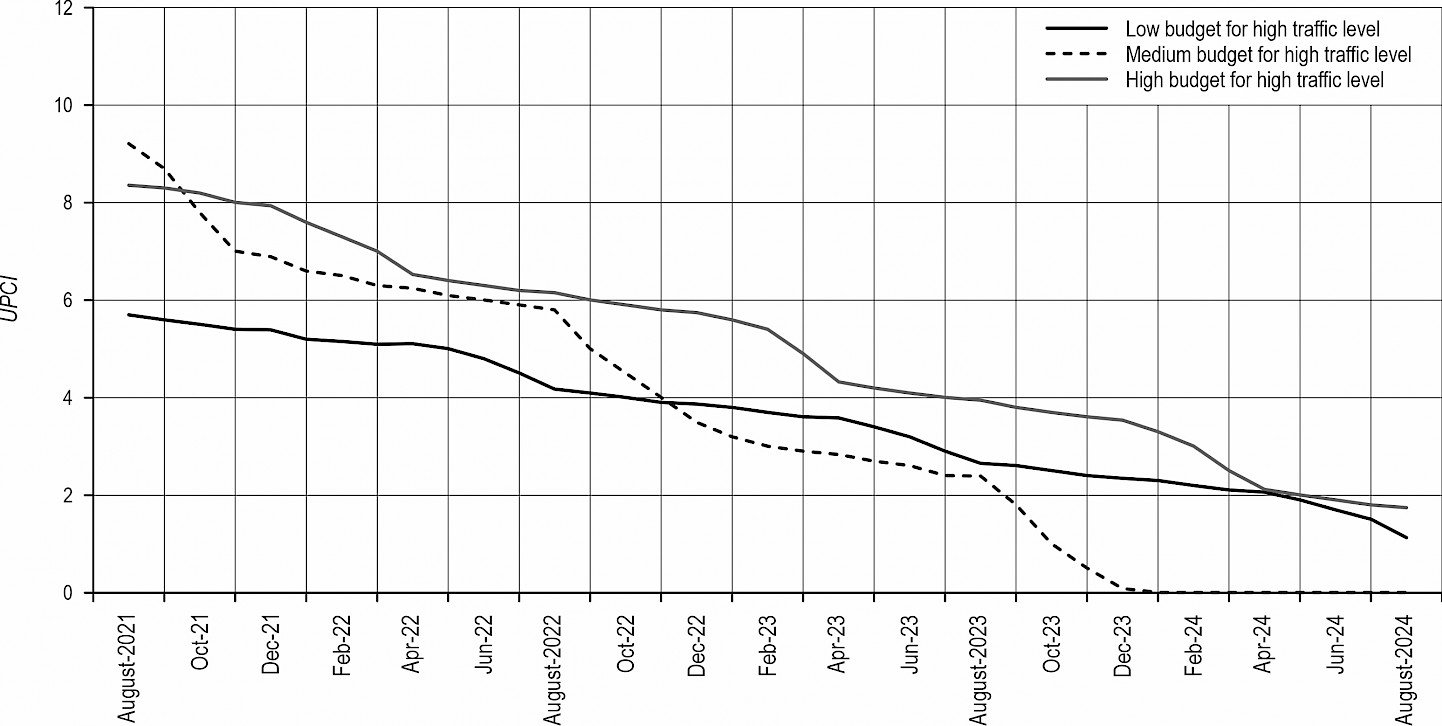
Fig. 8g UPCI performance curves over time for roads with different maintenance strategy and high traffic levels in sub-humid zone
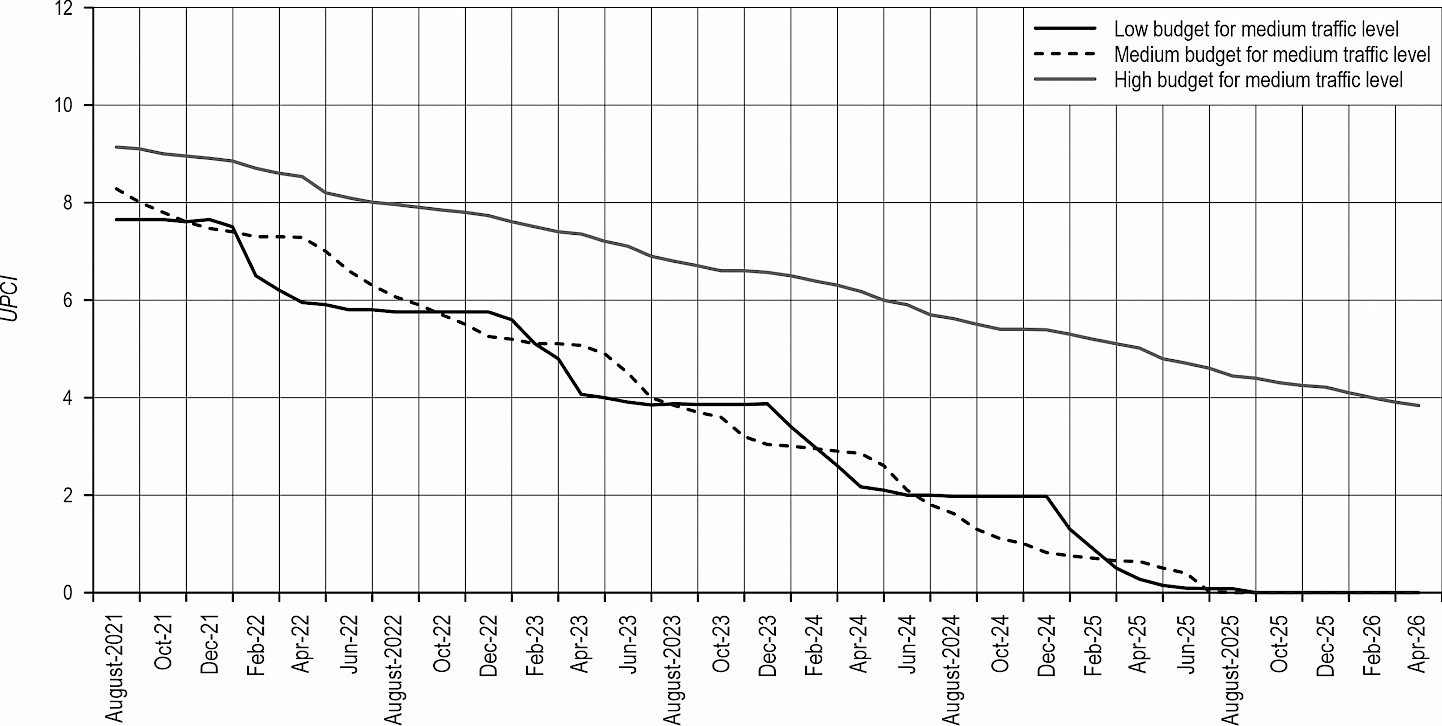
Fig. 8h UPCI performance curves over time for roads with different maintenance strategy and medium traffic levels in sub-humid zone
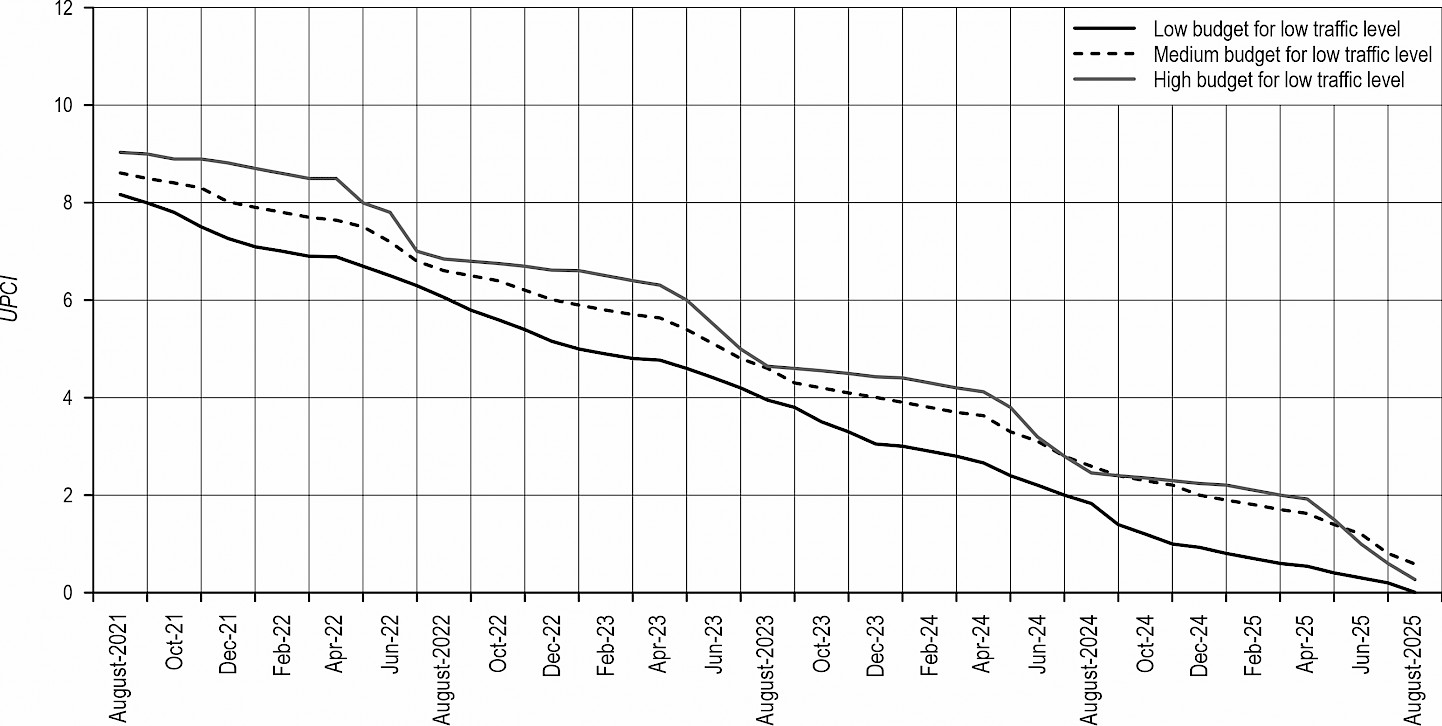
Fig. 8i UPCI performance curves over time for roads with different maintenance strategy and low traffic levels in sub-humid zone
3.5 Determining Time based on Deterioration and Maintenance Cycle
In Mediterranean climate, where high and medium-traffic roads were maintained by high-budget strategy, deterioration time was longer than with other maintenance strategies and the number of maintenance per decade was lower. In contrast, in low-traffic roads, the number of maintenance per decade after low-budget maintenance activities was higher than with other strategies. In a semi-arid climate, where high-traffic roads were maintained by low-budget strategy, deterioration time was longer than with other maintenance strategies and the number of maintenance per decade was lower. High-budget maintenance activities in low and medium-traffic roads, made the maintenance cycle longer compared to other strategies. In sub-humid climate, where high, medium, and low-traffic roads were maintained by high-budget strategy, deterioration time was longer than with other maintenance strategies, and the number of maintenance per decade was lower (Table 6).
Table 6 Time based on deterioration and maintenance cycle according to maintenance strategy and traffic
|
Maintenance strategy |
Mediterranean |
Semi-arid |
Sub-humid |
||||
|
Time to deterioration month |
Maintenance per 10 years |
Time to deterioration month |
Maintenance per 10 years |
Time to deterioration month |
Maintenance per 10 years |
||
|
Low B & high T |
14 |
8.6 |
36 |
3.3 |
10 |
12 |
|
|
Medium B & high T |
15 |
8.0 |
32 |
3.7 |
14 |
8.6 |
|
|
High B & high T |
16 |
7.5 |
28 |
4.3 |
20 |
6.0 |
|
|
Low B & medium T |
27 |
4.4 |
18 |
6.7 |
19 |
6.3 |
|
|
Medium B & medium T |
33 |
3.6 |
46 |
2.6 |
19 |
6.3 |
|
|
High B & medium T |
35 |
3.4 |
49 |
2.4 |
43 |
2.8 |
|
|
Low B & low T |
35 |
3.4 |
19 |
6.3 |
18 |
6.7 |
|
|
Medium B & low T |
32 |
3.7 |
52 |
2.3 |
23 |
5.2 |
|
|
High B & low T |
28 |
4.3 |
54 |
2.2 |
24 |
5.0 |
|
|
* B – Budget; T – Traffic |
|||||||
3.6 Determining Cost-Effectiveness of Different Maintenance Strategies
The cost-effectiveness analysis evaluates the effects of maintenance strategy during the whole life cycle of a road. From this analysis, the optimal maintenance strategy was determined for each traffic level in different climate zones. In the Mediterranean climate zone, employing low-budget maintenance strategy at all traffic levels was the most effective. In semi-arid climate zone, CE values of low-budget maintenance strategy were higher than those of other strategies only in high-traffic roads. In medium and low-traffic roads, the medium-budget maintenance strategies were more efficient based on CE analysis. In a sub-humid climate, CE values severely vary depending on the traffic level. Medium, high, and low-budget maintenance strategies were respectively efficient in high, medium, and low-traffic roads based on CE values (Table 7).
Table 7 Cost-effectiveness analysis of maintenance strategies in different traffic levels
|
Maintenance strategy |
Mediterranean |
Semi-arid |
Sub-humid |
||||||
|
E |
UE |
CE |
E |
UE |
CE |
E |
UE |
CE |
|
|
Low B & high T |
81.2 |
38.2 |
1.35 |
210.5 |
50.2 |
3.51 |
23.3 |
27.9 |
0.39 |
|
Medium B & high T |
70.2 |
45.9 |
0.68 |
214.3 |
52.3 |
2.09 |
71.2 |
62.1 |
0.69 |
|
High B & high T |
147.9 |
53.6 |
0.95 |
240.1 |
62.6 |
1.55 |
84.6 |
52.5 |
0.54 |
|
Low B & medium T |
95.5 |
44.5 |
1.59 |
69.9 |
52.8 |
1.16 |
28.0 |
47.5 |
0.47 |
|
Medium B & medium T |
104.7 |
49.8 |
1.02 |
176.6 |
55.7 |
1.72 |
42.9 |
53.8 |
0.42 |
|
High B & medium T |
77.4 |
54.3 |
0.50 |
202.8 |
61.0 |
1.31 |
125.5 |
62.4 |
0.81 |
|
Low B & low T |
27.7 |
44.6 |
0.46 |
29.3 |
55.3 |
0.49 |
15.1 |
51.7 |
0.25 |
|
Medium B & low T |
30.1 |
49.8 |
0.29 |
71.4 |
56.3 |
0.70 |
18.9 |
57.1 |
0.18 |
|
High B & low T |
26.3 |
54.3 |
0.17 |
74.7 |
59.7 |
0.48 |
23.8 |
60.3 |
0.15 |
|
* B – Budget; T – Traffic; E – Effectiveness; UE – Unit Effectiveness; CE – Cost Effectiveness |
|||||||||
4. Discussion
Surface evaluation and deterioration process of the existing forest roads is essential to determine the maintenance strategy and time that can provide benefits to road users and decision makers (Maeda et al. 2018). Various maintenance strategies with different budget levels have been developed to repair road damage rapidly and improve UPCI (Akay 2006, Aruga et al. 2022). Although in the present study, the three studied sites were located in the same biome, they were different in terms of climate. We found that forest roads deteriorate over time due to the combined effects of traffic and climate. From the analysis, the medium and high-budget maintenance road is in good condition in the first and second year because of an extensive maintenance and reconstruction process. The annual deterioration of roads maintained by high budget in Mediterranean, semi-arid, and sub-humid climates was 15.5%, 15.6% and 23.9%, respectively. These values for the roads maintained by low-budget strategy were 21.4%, 29.7%, and 24.8% in Mediterranean, semi-arid and sub-humid climates, respectively. Heydari et al. (2018) showed that scheduling and optimization of maintenance operations reduced the maintenance budget from 25% to 73% during the first years. In this study, in all climate zones, UPCI values for roads with a low traffic were higher than for the roads in other two traffic levels. A similar finding was recorded by Girardin et al. (2022). They showed that narrow and low-traffic roads tended to degrade more rapidly over time. Moreover, Ciobanu et al. (2012) found that the degradation forms of forest roads and their extension on the gravel forest road are affected by traffic volume.
Different climates result in different weather events including frequency of peak flows, temperature, evaporation patterns, precipitation time, duration and form of rainfall. These climatic factors will have a significant impact on the wearing course quality (Dodson 2021). From the mean data analysis, it is observed that there is significant difference among climates. Sub-humid climates had significantly lower UPCI (7.19) than the two other climates. This result agreed with the findings of Akgul et al. (2017), who indicated that volumetric degradation on the forest road surfaces is related to meteorological factors, especially total rainfall. In humid climates, thunderstorms often cause heavier rain than in two other climates, and this makes severe runoff flow (Fidelus-Orzechowska et al. 2018). In a humid climate, precipitation changes can rapidly alter the moisture content in the road foundations and influence the deterioration course. Water enters the wearing course causing potholing and a rapid loss of surface condition (Shao et al. 2017, Akgul et al. 2017). Chamorro Giné and Tighe (2019) successfully developed a framework for sustainable rural road networks for roads in arid, Mediterranean, and humid climates. Fidelus-Orzechowska et al. (2020) used a terrestrial laser scanner to analyze surface changes on an abandoned forest road. Research has shown a significant relationship between the flow velocity and the magnitude of damage on forest roads. Qiao et al. (2020) used life-cycle cost analysis (LCCA) to find an economic climate adaptation method and improve the International Roughness Index (IRI) of roads in Virginia (humid and sub-tropical climates) for the period 2020–2039. They reported that wearing course is affected by climate factors, including air temperature, precipitation, wind speed, sunshine percentage, and humidity. The findings of this study lead to a 1–5% reduction in IRI, a 4–14% reduction in rutting, and a 3–53% reduction in cracking.
In the Mediterranean climates, where high and medium-traffic roads were maintained by a high-budget strategy, deterioration time was longer than with other maintenance strategies, and the maintenance number per decade was lower. High-budget maintenance activities include one drainage and improvement per two km, heavy blading with reshaping, forming and compaction, 100 mm layer graveling, and pothole patching (Chamorro Giné and Tighe 2019). In low-traffic roads, low-budget maintenance was found to be more effective, and rehabilitation cycle (3.4 per 10 years) was longer compared to the other strategies. In a semi-arid climate, where high-traffic roads were maintained by low budget strategy, deterioration time was longer than with different maintenance strategies, and the number of maintenance per decade was lower. Low-budget maintenance activities include one drainage and culvert improvement per 6 km, light blading or grading, 30 mm layer graveling and pothole patching (Chamorro Giné and Tighe 2019). In low and medium-traffic roads, high-budget maintenance was found to be more effective and the rehabilitation cycle was longer compared to the other strategies. In sub-humid climates, where high, medium and low-traffic roads were maintained by high-budget strategy, deterioration time was longer than with different maintenance strategies, and the number of maintenance per decade was lower.
In Mediterranean and semi-arid climate zones, it was observed that in most cases, CE values of low-budget maintenance strategy were more efficient than other strategies in all traffic levels. The reason for this is that low maintenance funding is more cost-effective than other funding levels in the long term. In sub-humid climates, CE values severely vary depending on the traffic levels. Medium, high, and low-budget maintenance strategies were adequately efficient in high, medium, and low-traffic roads based on CE values.
5. Conclusions
The protection and maintenance of forest roads should be done in such a way that they can resist climate stress and not deteriorate quickly. This study attempted to identify a suitable maintenance strategy and budget to improve the resistance of road surfacing layers against different traffic levels. Cost-effective and efficient reconstruction of forest roads is very important, especially in high-traffic routes that often have high technical standards and provide access to different parts of the forest. In this study, it was concluded that the effects of maintenance budget differ among climates. In a sub-humid climate, high-budget maintenance activities not only performed better over time but were also economically advantageous compared to other budgets, especially in medium-traffic roads. In a semi-arid climate, low-budget maintenance activities were only effective in high-traffic roads, while the medium-budget activities were effective in medium and low-traffic roads with low bearing capacity and surfacing quality. Low-budget maintenance activities were cost-effective for the sustainable management of roads in the Mediterranean climate. Overall, it was concluded that monitoring UPCI over time and making probability analysis using time series is helpful for a sustainable and long-term management of forest roads. This research provided new techniques and tools for cost-effective maintenance and sustaining access to forests in three climate zones of Hyrcanian forests. Moreover, the Markov chain proved to be a prospective method for predicting and solving wearing course problems.
Acknowledgments
We gratefully acknowledge the Iran National Science Foundation (Vice-Presidency for Science and Technology) for the financial support of this work (Research plan No: 4000827). We would also like to thank Gorgan University of Agricultural Sciences and Natural Resources for the support of this PhD thesis as well as anonymous reviewers whose comments and suggestions helped improve the manuscript.
6. References
Akgul, M., Yurtseven, H., Akburak, S., Demir, M., Cigizoglu, H.K., Ozturk,T., Eksi, M., Akay, A.O., 2017: Short term monitoring of forest road pavement degradation using terrestrial laser scanning. Measurement 103: 283–293. https://doi.org/10.1016/j.measurement.2017.02.045
Akgul, M., Akburak, S., Yurtseven, H., Akay, A., Cigizoglu, H., Demir, M., Ozturk, T., Eksi, M., 2019: Potential impacts of weather and traffic conditions on road surface performance in terms of forest operations continuity. Applied Ecology and Environmental Research 17: 2533–2550. https://doi.org/10.15666/aeer/1702_25332550
Aruga, K., Sekiguchi, T., Sato, T., Shuin, Y., 2022: Evaluation of forest road damages using return periods caused by heavy rains in Kanuma and Nikko cities of Tochigi Prefecture, Japan. Forestist 72(1): 29–40. https://doi.org/10.5152/forestist.2021.21013
Akay, A.E., 2006: Minimizing total costs of forest roads with computer-aided design model. Sadhana 31: 621–633. https://doi.org/10.1007/BF02715918
Akay, A.O., Akgul, M., Demir, M., Acar, H.H., 2020: Analysis of factors associated with the amount of forest road reconstruction activity in Turkey: Autoregressive distributed lag modelling approach. Forest Ecology and Management 458: 117–125. https://doi.org/10.1016/j.foreco.2019.117800
Akay, A.E., Serin, H., Sessions, J., Bilici, E., Pak, M., 2021:Evaluating the effects of improving forest road standards on economic value of forest products. Croatian Journal of Forest Engineering 42(2): 245–258. https://doi.org/10.5552/crojfe.2021.851
Bicici, S., Zeybek, M., 2020: An approach for the automated extraction of road surface distress from a UAV-derived point cloud. Automation in Construction 122: 57–64. https://doi.org/10.1016/j.autcon.2020.103475
Chamorro Giné, M.A., Tighe, S., 2019: Development and application of a sustainable management system for unpaved rural road networks. Journal of Transportation Research Board 2673(12): 891–901. https://doi.org/10.1177/0361198119864908
Chamorro Giné, M.A., Tighe, S., 2009: Development of a management framework for rural roads in developing countries. Journal of Transportation Research Board 2093(1): 99–107. https://doi.org/10.3141/2093-12
Ciobanu, V., Alexandru, V., Saceanu, S., 2012: Degradation forms of forest gravel road roadways under heavy vehicles used in timber transport. Agriculture and Food Engineering 5(54): 37–45.
Dadrasjavan, F., Zarrinpanjeh, N., Ameri, A., 2019: Automatic crack detection of road pavement based on aerial UAV imagery. Civil Engineering 146: 1–16. https://doi.org/10.20944/preprints201907.0009.v1
Dodson, E.M., 2021: Challenges in forest road maintenance in North America. Croatian Journal of Forest Engineering 42(1): 107–116. https://doi.org/10.5552/crojfe.2021.777
Elhadidy, A.A., Elbeltagi, E.E., Ammar, M.A., 2015: Optimum analysis of pavement maintenance using multi-objective genetic algorithms. Housing and Building Natinal Research Center Journal 11(1): 107–113. https://doi.org/10.1016/j.hbrcj.2014.02.008
Ferenčík, M., Kardoš, M., Allman, M., Slatkovská, Z., 2019: Detection of forest road damage using mobile laser profilometry. Computers and Electronics in Agriculture 166: 48–55. https://doi.org/10.1016/j.compag.2019.105010
Fidelus-Orzechowska, J., Strzyżowski, D., Cebulski, J., Wrońska-Wałach, D., 2020: A quantitative analysis of surface changes on an abandoned forest road in the Lejowa Valley (Tatra Mountains, Poland). Remote Sensing 12(20): 3467–3475. https://doi.org/10.3390/rs12203467
Fidelus-Orzechowska, J., Strzyżowski, D., Żelazny, M., 2018: The geomorphic activity of forest roads and its dependencies in the Tatra Mountains. Geografiska Annaler, Series A: Physical Geography 100(1): 59–74. https://doi.org/10.1080/04353676.2017.1376585
Fraefel, M., Bont, L., Fischer, C., 2021: Spatially explicit assessment of forest road suitability for timber extraction and hauling in Switzerland. European Journal of Forest Research 140(5): 1195–1209. https://doi.org/10.1007/s10342-021-01393-w
Girardin, P., Valeria, O., Girard, F., 2022: Measuring spatial and temporal gravelled forest road degradation in the boreal forest. Remote Sensing 14(3): 457–465. https://doi.org/10.3390/rs14030457
Gotosa, J., Nyamadzawo, G., Mtetwa, T., Kanda, A., Dudu, V.P., 2015: Comparative road dust suppression capacity of molasses stillage and water on gravel road in Zimbabwe. Journal of Advanced Research 3(2): 198–208. https://doi.org/10.9734/AIR/2015/13019
Goudarzi, R., Najafi, A., 2018: Multi-criteria decision-making methods in the management of forest road maintenance. Journal of Forest and Wood Products 70(4): 111–119. https://doi.org/10.22059/JFWP.2018.214809.776
Guo, X., Hao, P., 2021: Using a random forest model to predict the location of potential damage on asphalt pavement. Applied Sciences 11(21): 103–111. https://doi.org/10.3390/app112110396
Grajewski, S.M., 2016: Influence of pavement moisture content on the load-bearing capacity of forest road. Infrastructure and Ecology of Rural Areas 4(2): 1451–1462. https://doi.org/10.14597/infraeco.2016.4.2.107
Hrůza, P., Mikita, T., Tyagur, N., Krejza, Z., Cibulka, M., Procházková, A., Patočka, Z., 2018: Detecting forest road wearing course damage using different methods of remote sensing. Remote Sensing 10(4): 492–500. https://doi.org/10.3390/rs10040492
Heidari, M.J., Najafi, A., Alavi, S.J., 2018: Pavement deterioration modeling for forest roads based on logistic regression and artificial neural networks. Croatian Journal of Forest Engineering 39(2): 271–287.
Hillier, F., Lieberman, G., 2005: Introduction to operations research. Tata McGraw Hill Education, 1152 p.
Maeda, H., Sekimoto, Y., Seto, T., Kashiyama, T., Omata, H., 2018: Road damage detection and classification using deep neural networks with smartphone images. Computer-Aided Civil and Infrastructure Engineering 33(12): 1127–1141. https://doi.org/10.1111/mice.12387
Osorio-Lird, A., Chamorro, A.,Videla, C., Tighe, S., Torres-Machi, C., 2018: Application of Markov chains and Monte Carlo simulations for developing pavement performance models for urban network management. Structure and Infrastructure Engineering 14(9): 112–119. https://doi.org/10.1080/15732479.2017.1402064
Pazhouhan, I., Fathizadeh, O., Kamkar Rouhani, A., Vahidi, J., Najafi, A., 2020: Time and cost simulation of forest roads construction using Monte Carlo analysis. Ecology of Iranian Forest 8(15): 128–135. http://ifej.sanru.ac.ir/article-1-297-fa.pdf
Parsakhoo, A., Hosseini, S.A., Lotfalian, M., Mohammadi, J., Salarijazi, M., 2021: Efficiency of different anti-dust agents in reducing dust emission from forest road and deposition on leaf surface. Croatian Journal of Forest Engineering 42(2): 269–282. https://doi.org/10.5552/crojfe.2021.740
Parsakhoo, A., Lotfalian, M., Hosseini, S.A., 2010: Forest roads planning and construction in Iranian forestry. Journal of Civil Engineering and Construction Technology 1(1): 14–18.
Qiao, Y., Santos, J., Stoner, A.M.K., Flinstch, G., 2020: Climate change impacts on asphalt road pavement construction and maintenance. Journal of Industrial Ecology 24(2): 342–355. https://doi.org/10.1111/jiec.12936
Ruzgienė, B., Aksamitauskas, Č., Daugėla, I., Prokopimas, Š., Puodžiukas, V., Rekus, D., 2015: UAV photogrammetry for road surface modeling. The Baltic Journal of Road and Bridge Engineering 10(2): 151–158. https://doi.org/10.3846/bjrbe.2015.19
Saha, P., Ksaibati, K., 2017: Developing an optimization model to manage unpaved roads. Journal of Advanced Transportation 2017: 1–11. https://doi.org/10.1155/2017/9474838
Setyawan, A., Nainggolan, J., Budiarto, A., 2015: Predicting the remaining service life of road using pavement condition index. Procedia Engineering 125: 417–423. https://doi.org/10.1016/j.proeng.2015.11.108
Shao, Z., Jenkins, G., Oh, E., 2017: Assessment the impacts of climate change on road infrastructure. International Journal of GEOMATE 13: 120–128. https://doi.org/10.21660/2017.38.72099
Tan, Y., Li, Y., 2019: UAV Photogrammetry-based 3D road distress detection. International Journal of Geo-Information 8: 1–24. https://doi.org/10.3390/ijgi8090409
Yurtseven, H., Akgul, M., Akay, A.O., Akburak, S., Cigizoglu, H.K., Demir, M., Ozturk, T., Eksi, M., 2019: High accuracy monitoring system to estimate forest road surface degradation on horizontal curves. Environmental Monitoring and Assessment 191: 1–17. https://doi.org/10.1007/s10661-018-7155-8
Yoshida, M., Takahashi, H., Sakai, H., 2016: Analysis of alternative forest road retaining technologies on difficult slopes in Japan. European Journal of Forest Engineering 2(2): 61–66.
© 2023 by the authors. Submitted for possible open access publication under the
terms and conditions of the Creative Commons Attribution (CC BY) license (http://creativecommons.org/licenses/by/4.0/).
Authors' addresses:
Aiub Rezaee Motlagh, MSc
e-mail: aiubrezaee@yahoo.com
Assoc. prof. Aidin Parsakhoo, PhD *
e-mail: Parsakhoo@gau.ac.ir
Assoc. prof. Jahangir Mohammadi, PhD
e-mail: Mohamdi.jahangir@gmail.com
Gorgan University of Agricultural Sciences and Natural Resources
Faculty of Forest Science
Basij Square
Gorgan, 49189-43464
IRAN
Assoc. prof. Akbar Najafi, PhD
e-mail: a.najafi@modares.ac.ir
Tarbiat Modares University
Faculty of Natural Resources and Marine Sciences
Jalal AleAhmad Nasr
P.O.Box: 14115-111
Tehran
IRAN
* Corresponding author
Received: September 28, 2022
Accepted: March 19, 2023
Original scientific paper

